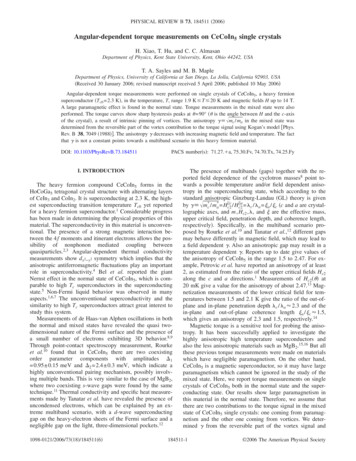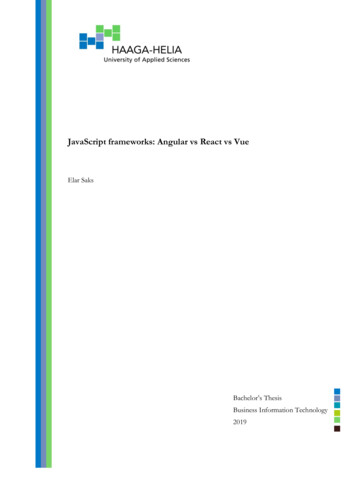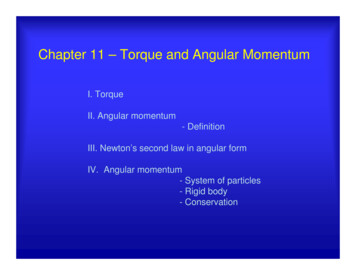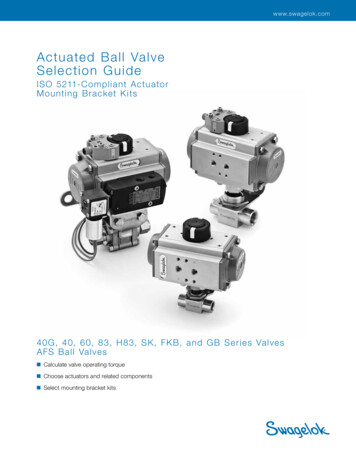
Transcription
PHYSICAL REVIEW B 73, 184511 共2006兲Angular-dependent torque measurements on CeCoIn5 single crystalsH. Xiao, T. Hu, and C. C. AlmasanDepartment of Physics, Kent State University, Kent, Ohio 44242, USAT. A. Sayles and M. B. MapleDepartment of Physics, University of California at San Diego, La Jolla, California 92903, USA共Received 30 January 2006; revised manuscript received 5 April 2006; published 10 May 2006兲Angular-dependent torque measurements were performed on single crystals of CeCoIn5, a heavy fermionsuperconductor 共Tc0 2.3 K兲, in the temperature, T, range 1.9 K ⱕ T ⱕ 20 K and magnetic fields H up to 14 T.A large paramagnetic effect is found in the normal state. Torque measurements in the mixed state were alsoperformed. The torque curves show sharp hysteresis peaks at 90 共 is the angle between H and the c-axisof the crystal兲, a result of intrinsic pinning of vortices. The anisotropy 冑mc / ma in the mixed state wasdetermined from the reversible part of the vortex contribution to the torque signal using Kogan’s model 关Phys.Rev. B 38, 7049 共1988兲兴. The anisotropy decreases with increasing magnetic field and temperature. The factthat is not a constant points towards a multiband scenario in this heavy fermion material.DOI: 10.1103/PhysRevB.73.184511PACS number共s兲: 71.27. a, 75.30.Fv, 74.70.Tx, 74.25.FyI. INTRODUCTIONThe heavy fermion compound CeCoIn5 forms in theHoCoGa5 tetragonal crystal structure with alternating layersof CeIn3 and CoIn2. It is superconducting at 2.3 K, the highest superconducting transition temperature Tc0 yet reportedfor a heavy fermion superconductor.1 Considerable progresshas been made in determining the physical properties of thismaterial. The superconductivity in this material is unconventional. The presence of a strong magnetic interaction between the 4f moments and itinerant electrons allows the possibility of nonphonon mediated coupling betweenquasiparticles.2,3 Angular-dependent thermal conductivitymeasurements show dx2 y2 symmetry which implies that theanisotropic antiferromagnetic fluctuations play an importantrole in superconductivity.4 Bel et al. reported the giantNernst effect in the normal state of CeCoIn5, which is comparable to high Tc superconductors in the superconductingstate.5 Non-Fermi liquid behavior was observed in manyaspects.1,6,7 The unconventional superconductivity and thesimilarity to high Tc superconductors attract great interest tostudy this system.Measurements of de Haas-van Alphen oscillations in boththe normal and mixed states have revealed the quasi twodimensional nature of the Fermi surface and the presence ofa small number of electrons exhibiting 3D behavior.8,9Through point-contact spectroscopy measurement, Rourkeet al.10 found that in CeCoIn5 there are two coexistingorder parameter components with amplitudes 1 0.95 0.15 meV and 2 2.4 0.3 meV, which indicate ahighly unconventional pairing mechanism, possibly involving multiple bands. This is very similar to the case of MgB2,where two coexisting s-wave gaps were found by the sametechnique.11 Thermal conductivity and specific heat measurements made by Tanatar et al. have revealed the presence ofuncondensed electrons, which can be explained by an extreme multiband scenario, with a d-wave superconductinggap on the heavy-electron sheets of the Fermi surface and anegligible gap on the light, three-dimensional he presence of multibands 共gaps兲 together with the reported field dependence of the cyclotron masses8 point towards a possible temperature and/or field dependent anisotropy in the superconducting state, which according to thestandard anisotropic Ginzburg-Landau 共GL兲 theory is given兩兩c兩兩a/ Hc2 c / a a / c 共c and a are crystalby 冑m*c / m*a Hc2lographic axes, and m , Hc2 , , and are the effective mass,upper critical field, penetration depth, and coherence length,respectively兲. Specifically, in the multiband scenario proposed by Rourke et al.10 and Tanatar et al.,12 different gapsmay behave differently in magnetic field, which may lead toa field dependent . Also an anisotropic gap may result in atemperature dependent . Reports up to date give values ofthe anisotropy of CeCoIn5 in the range 1.5 to 2.47. For example, Petrovic et al. have reported an anisotropy of at least2, as estimated from the ratio of the upper critical fields Hc2along the c and a directions.1 Measurements of Hc2共 兲 at20 mK give a value for the anisotropy of about 2.47.13 Magnetization measurements of the lower critical field for temperatures between 1.5 and 2.1 K give the ratio of the out-ofplane and in-plane penetration depth c / a 2.3 and of thein-plane and out-of-plane coherence length a / c 1.5,which gives an anisotropy of 2.3 and 1.5, respectively.14Magnetic torque is a sensitive tool for probing the anisotropy. It has been successfully applied to investigate thehighly anisotropic high temperature superconductors andalso the less anisotropic materials such as MgB2.15,16 But allthese previous torque measurements were made on materialswhich have negligible paramagnetism. On the other hand,CeCoIn5 is a magnetic superconductor, so it may have largeparamagnetism which cannot be ignored in the study of themixed state. Here, we report torque measurements on singlecrystals of CeCoIn5 both in the normal state and the superconducting state. Our results show large paramagnetism inthis material in the normal state. Therefore, we assume thatthere are two contributions to the torque signal in the mixedstate of CeCoIn5 single crystals: one coming from paramagnetism and the other one coming from vortices. We determined from the reversible part of the vortex signal and184511-1 2006 The American Physical Society
PHYSICAL REVIEW B 73, 184511 共2006兲XIAO et al.found that is not a constant, instead, it is field and temperature dependent. This provides evidence that the picturein this unconventional superconductor is not a simple singleband scenario, supporting the conclusions of Rourke et al.10and Tanatar et al.12II. EXPERIMENTAL DETAILSHigh quality single crystals of CeCoIn5 were grown usinga flux method. The superconducting transition temperatureTc, defined as the value of T at zero resistivity, is 2.3 K. Thesurfaces of the single crystals were etched in concentratedHCl for several hours and then thoroughly rinsed in ethanolin order to remove the indium present on the surface. Themass of the single crystal for which the data are shown is0.75 mg. Angular dependent measurements of the magnetictorque experienced by the sample of magnetic moment M inan applied magnetic field H, were performed over a temperature range 1.9 K ⱕ T ⱕ 20 K and applied magnetic field range0.1 T ⱕ H ⱕ 14 T using a piezoresistive torque magnetometer. In this technique, a piezoresistor measures the torsion, ortwisting, of the torque lever about its symmetry axis as aresult of the magnetic moment of the single crystal. Thesample was rotated in the applied magnetic field betweenH 储 c-axis 共 0 兲 and H 储 a-axis 共 90 兲 and the torques incand dec were measured as a function of increasing and decreasing angle, respectively, under various temperature-fieldconditions.The contributions of the gravity and puck to the totaltorque signal were measured and subtracted from it. To measure the background torque due to gravity, we measured thetorque signal at different temperatures in zero applied magnetic field with the sample mounted on the puck. The gravitytorque is almost temperature independent and it is negligibleat high applied magnetic fields. However, as the appliedmagnetic field decreases, the total torque signal becomessmaller and the effect of gravity becomes important, henceshould be subtracted from the measured torque. To determinethe contribution of the puck to the measured torque, we measured the torque without the single crystal on the puck atdifferent magnetic fields and temperatures. The magnitude ofthe torque of the puck increases with increasing magneticfield. Also, the contribution of the puck to the measuredtorque is much larger than the contribution of the gravity.Therefore, the former contribution should always be subtracted from the total measured torque signal.III. RESULTS AND DISCUSSIONPrevious torque studies of Tl2Ba2CuO6 共Ref. 17兲 andMgB2 共Refs. 15 and 16兲 systems have shown that the normalstate torque coming from paramagnetism is small comparedwith the flux-vortex torque, therefore, one could neglect theformer contribution to the total torque signal measured in thesuperconducting state. However, this is not the case forCeCoIn5, for which the paramagnetic torque signal in thenormal state is comparable with the total torque signal measured in the superconducting state, as shown below. Hence,one needs to subtract the former signal from the latter oneFIG. 1. 共Color online兲 Angular dependence of the paramagnetic torque p measured in the normal state of CeCoIn5 at differenttemperatures T and applied magnetic field H values. The solid linesare fits of the data with Eq. 共1兲. Inset, sketch of the single crystalwith the orientation of the magnetic field H and torque with respect to the crystallographic axes.in order to determine the torque due to vortices. This issimilar to the case of the electron-doped high-Tc cuprateNd1 xCexCuO4, where a large paramagnetic contributionfrom Nd ions is discussed separately from a superconductingcontribution.18 Therefore, we first discuss the field and temperature dependence of the magnetic torque in the normalstate and show how we subtract this contribution from themeasured torque in the mixed state, and then we return to thediscussion of the torque signal in the mixed state and to thedetermination of the field and temperature dependence of thebulk anisotropy.All the torque curves measured in the normal state, someof which are shown in Fig. 1, are perfectly sinusoidal andcan be well fitted with p共T,H, 兲 A共T,H兲sin 2 ,共1兲where A is a temperature and field dependent fitting parameter. Indeed, note the excellent fit of the data of Fig. 1 withEq. 共1兲 共solid lines in the figure兲. The field dependence ofA / H at 1.9, 6, 10, and 20 K is shown in Fig. 2. The solidlines are linear fits to the data, which show that A / H is linearin H with a negligible y-intercept and a slope which increases with decreasing T. So A is proportional to H2, i.e.,A共T,H兲 C共T兲H2 ,共2兲with C a temperature dependent fitting parameter.Next we show that the torque measured in the normalstate and given by Eq. 共1兲 is a result of the paramagnetism.Indeed, the torque of a sample of magnetic moment Mplaced in a magnetic field H is given byជ Hជ. ជ p共T,H兲 M共3兲ជ can always be decomThe resultant magnetic moment Mposed into a component parallel M 储 and one perpendicularM to the ab-plane of the single crystal. With the magneticfield H making an angle with the c-axis of the single crystal, Eq. 共3兲 becomes184511-2
PHYSICAL REVIEW B 73, 184511 共2006兲ANGULAR-DEPENDENT TORQUE MEASUREMENTS ON¼FIG. 2. 共Color online兲 Field H dependence of A / H, where A isthe fitting parameter in Eq. 共1兲. The solid lines are linear fits of thedata. ជ p共T,H, 兲 共M 储H cos M H sin 兲k̂.共4兲On the other hand, the experimental relationship of thetorque, given by Eq. 共1兲 with the fitting parameter A given byEq. 共2兲, becomes p共T,H, 兲 A共T,H兲sin 2 2C共T兲H2 sin cos .共5兲Therefore, with C 共C1 C2兲 / 2, Eqs. 共4兲 and 共5兲 giveM 储 C1H sin aH储 ,where C1 a, the a-axis susceptibility, andM C2H cos cH ,共6兲where C2 c, the c-axis susceptibility. This shows that thetorque measured experimentally is of the form p共T,H, 兲 a c 2H sin 2 .2共7兲The fact that A / H 共 a c兲H / 2 共M 储 M 兲 / 2 关see Eqs. 共5兲and 共7兲兴 shows that A / H plotted in Fig. 2 reflects the anisotropy of the magnetic moments along the two crystallographic directions, a and c, while its linear field dependenceshows that the magnetic moments are linear in H, hence thesusceptibilities along these two directions are field independent. The temperature dependence of the magnetic momentsis given by the temperature dependence of the parameter C.Therefore, Eq. 共7兲 shows that the T, H, and dependences ofthe torque measured in the normal state of CeCoIn5 reflect itsparamagnetism and the anisotropy of its susceptibility a c along the a and c directions.To further check the consistency of the data and to precisely determine the paramagnetic value of the torque, wealso measured the magnetic moment M of the same singlecrystal of CeCoIn5 using a superconducting quantum interference device 共SQUID兲 magnetometer. The magnetic moments measured at 4, 6, 10, 15, and 20 K are plotted in themain panel of Fig. 3 as a function of the applied magneticfield for both H 储 c-axis 共 0 兲 and H储 a-axis 共 90 兲. TheFIG. 3. Plot of the magnetic moment M vs applied magneticfield H, with H 储 c-axis 共solid symbols兲 and H 储 a-axis 共open symbols兲, measured at 4, 6, 10, 15, and 20 K. Inset, susceptibility vstemperature T, measured with H 储 c-axis and H 储 a-axis.magnetic moments for both field orientations are linear in Hwith M 储 M for all temperatures measured, consistent withthe torque data of Fig. 2 and with Eq. 共6兲. Note that the unitsfor the magnetic moments of Figs. 2 and 3 are different. Wechange the units and compare the results of the two types ofmeasurements. For example, the torque measured at 6 K and5 T gives A / H 1.42 10 7 A m 1. Since A / H 共M 储 M 兲 / 2, M M 储 M 2.84 10 7 A m 1. The SQUIDmeasurements give at the same temperature and appliedmagnetic field M 7.2 10 4 emu 7.2 10 7 A m 1 andM 储 4.2 10 4 emu 4.2 10 7 A m 1; hence, an anisotropy M 3.03 10 7 A m 1. Therefore, the values of the magnetic moments obtained in the two types of measurementsare within 5% of each other, an error well within our experimental error.The inset to Fig. 3 is a plot of the susceptibilities alongthe two directions, calculated from the slopes of M共H兲 ofFig. 3. Clearly 共T兲 shows anisotropy with respect to thefield orientation. Note that the susceptibilities for both directions increase with decreasing temperature. The continuousincrease of 共T兲 in the investigated temperature rangemay be related with the non-Fermi liquid behavior due tothe proximity to the quantum critical field. 19 These valuesof c and a are consistent with the ones reported by othergroups. 7The above study of the magnetic torque in the normalstate has shown that the contribution of paramagnetism to thetorque signal is very large, it has a quadratic H dependence,and also a T dependence 关see Eqs. 共1兲 and 共2兲兴. Therefore, toextract the vortex torque in the mixed state, one needs toaccount for this paramagnetic contribution and subtract thetwo background contributions from the measured torque. Thegravity and puck contributions to the measured torque weredetermined and subtracted as explained in the Experimentaldetails section. The resultant torque includes the paramagnetic p and the vortex v contributions and is plotted in theinset to Fig. 4. We need to mention here that the vortex andparamagnetic torque contributions have opposite signs sincethe magnetic moment representing the vortex torque is diamagnetic.184511-3
PHYSICAL REVIEW B 73, 184511 共2006兲XIAO et al.FIG. 4. 共Color online兲 Angular dependence of the reversibletorque rev, measured in the mixed state of CeCoIn5 at a temperature T of 1.9 K and an applied magnetic field H of 0.3 T. The solidline is a fit of the data with Eq. 共9兲. Inset, dependence of thehysteretic torque , measured in increasing and decreasing angle atthe same T and H.The inset to Fig. 4 is the angular-dependent torque measured in the mixed state at 1.9 K and 0.3 T in increasing anddecreasing angles. Again, this torque includes p and v.Note that 共 兲 displays hysteresis. This hysteretic behavior issimilar to the behavior in high Tc superconductors and is aresult of intrinsic pinning.20 The reversible component of thetorque is determined as the average of the torques measuredin increasing and decreasing angle; i.e., rev 共 dec inc兲/2.共8兲A plot of rev共 兲, obtained from inc共 兲 and dec共 兲 data isshown in the main panel of Fig. 4. The reversible componentof the torque reflects equilibrium states, hence it allows thedetermination of thermodynamic parameters. In the threedimensional anisotropic London model in the mixed state,the vortex torque v is given by Kogan’s model.21 We assumethat the paramagnetic contribution in the mixed state is givenby Eq. 共1兲. Therefore, rev共 兲 p v a sin 2 冉 冊兩兩c Hc2 0HV 2 1 sin 2 ln,2 共 兲H 共 兲16 0 ab共9兲where a is a fitting parameter, V is the volume of the sample, 0 is the vacuum permeability, ab is the penetration depth inthe ab-plane, 冑mc / ma, 共 兲 共sin2 2 cos2 兲1/2, is a兩兩cnumerical parameter of the order of unity, and Hc2is the兩兩cupper critical field parallel to the c-axis 关Hc2共1.9 K兲2 2.35 T兴. We define 0HV / 共16 0 ab兲.To obtain the field dependence of the anisotropy , we fitthe torque data with Eq. 共9兲, with a, , and as three fittingparameters. The solid line in the main panel of Fig. 4 is thefitting result for T 1.9 K and H 0.3 T. We need to mentionhere that the value of the fitting parameter a is 20% smallerthan what we would expect from the extrapolation of thenormal state paramagnetic torque data. Also, a has an HFIG. 5. Magnetic field H dependence of the fitting parameter .The solid line is a guide to the eye. Inset, enlarged plot of the lowfield region of the data in the main panel.dependence with an exponent of 2.3 instead of 2. So, eitherthere is extra contribution from other physics which has aweak field dependence, in addition to the paramagnetismcontribution, or maybe the paramagnetic contribution becomes smaller in the mixed state of CeCoIn5. Further experiments are needed to clarify this issue.Figure 5 is a plot of the field dependence of . The Insetis an enlarged plot of the low field region. Note that displays linear behavior up to a certain field with no y-intercept,then it deviates from linearity at H 0.5 T, and it increasesfast in the high field region. Since, on the one hand shouldbe field independent, and on the other hand, Eq. 共9兲 is validonly for applied magnetic fields much smaller than the uppercritical field, i.e., H Ⰶ Hc2共T兲 for a given temperature, weassume that 0.5 T, the field at which 共H兲 deviates fromlinearity, is the cutoff field Hcut for the applicability of theabove theory. The slope of 共H兲 in the linear H regime gives 共T 1.9 K兲 787 nm. This value is larger than previous reports, which give ab 600 nm from measurements using atunnel diode oscillator 22 and ab 330 nm from magnetization measurements.14Next, we fix to the three values given above and fit the rev共 兲 data with only two fitting parameters, a and . Theresultant field dependence of is shown in Fig. 6 for thedifferent values. The parameter is first decreasing withincreasing H, reaches a minimum at H 0.5 T, and then increases with further increasing field. As mentioned above,the cutoff field is 0.5 T. The data for H Hcut are not reliabledue to the failure of Kogan’s theory in this H region. So weconclude that the anisotropy decreases with increasingfield. We note that this field dependence of in CeCoIn5 isopposite with the one for MgB2,16 in which increases withincreasing field. We found that the value of is very sensitive to the value of , i.e., the larger the value of , the largerthe value of , with no effect however on its H dependence.To study the temperature dependence of , we performedtorque measurements in the mixed state at 1.9 K, 1.95,2.00 K in an applied magnetic field of 0.3 T, and determined from Eq. 共9兲. Figure 7 is a composite plot of the temperature dependence of the anisotropy. The squares give 共T兲determined from torque measurements as discussed above184511-4
PHYSICAL REVIEW B 73, 184511 共2006兲ANGULAR-DEPENDENT TORQUE MEASUREMENTS ON¼FIG. 6. 共Color online兲 Field H dependence of the anisotropy measured at 1.9 K.关with 共1.9 K兲 600 nm, 共1.95 K兲 670 nm, and 共2 K兲 740 nm taken from Ref. 25, the solid circles give兩兩c兩兩a 共T兲 calculated from the ratio of Hc2/ Hc2taken from previ23 while the triangles give 共T兲 determined fromous reports,冑 c共T兲 / a共T兲 measured in zero field 关see c共T兲 and a共T兲 ininset to Fig. 7兴. Note that the overall trend is a decrease ofthe anisotropy with increasing T, with a stronger dependencearound Tc共0.3 T兲 2.23 K. The values of obtained fromtorque measurements are well within the range previouslyreported. The fact that the anisotropy depends both on temperature and magnetic field could explain its relatively widerange of values reported in the literature.The field and temperature dependence of the anisotropyimplies the breakdown of the standard anisotropic GL theory,which assumes a single band anisotropic system with a temperature and field independent effective-mass anisotropy. Infact, a temperature and field dependent anisotropy was previously observed in NbSe2,24 LuNi2B2C,25 and MgB2,16,26the latter one having a value of similar with CeCoIn5. Veryrecently, Fletcher et al. reported measurements of thetemperature-dependent anisotropies 共 and 兲 of both theLondon penetration depth and the upper critical field ofMgB2.27 Their main result is that the anisotropies of the penetration depth and Hc2 in MgB2 have opposite temperaturedependences, but close to Tc they tend to a common value共see Fig. 4 of Ref. 27兲. This result confirms nicely the theoretical calculation of anisotropy based on a two-gapscenario.28 So, the temperature dependence of in CeCoIn5and MgB2 could have a similar origin. The field dependenceof could also be related with a multiband structure. In thisscenario, the response to an applied magnetic field may bedifferent in the case of the d-wave superconducting gap onthe heavy-electron sheets of the Fermi surface and the negligible gap on the light, three-dimensional pockets.FIG. 7. 共Color online兲 Composite plot of the temperature T dependence of the anisotropy . The circles show the results obtainedfrom the upper critical field data 共Ref. 26兲, the triangles are obtained from the resistivity data shown in the inset of this figure, andthe squares are from the present torque data measured in an appliedmagnetic field of 0.3 T. Inset, T dependence of the in-plane a andout-of-plane c resistivities measured in zero field.IV. SUMMARYTorque measurements were performed on CeCoIn5 singlecrystals in both the superconducting and normal states. Twocontributions to the torque signal in the mixed state wereidentified: one from paramagnetism and the other one fromthe vortices. The torque curves show sharp hysteresis peaksat 90 共 is the angle between H and the c-axis of thecrystal兲 when the measurements are done in clockwise andcounterclockwise directions. This hysteresis is a result of theintrinsic pinning of vortices, a behavior very similar to hightransition temperature cuprate superconductors. The temperature and magnetic field dependence of the anisotropy is obtained from the reversible part of the vortex torque. Wefind that decreases with increasing magnetic field and temperature. This result indicates the breakdown of theGinzburg-Landau theory, which is based on a single bandmodel and provides evidence for a multiband picture forCeCoIn5, which is highly possible due to its complex Fermitopology.8,9ACKNOWLEDGMENTSThe authors would like to thank Vladimir Kogan for fruitful discussions. This research was supported by the NationalScience Foundation under Grant No. DMR-0406471 at KSUand the US Department of Energy under Grant No. DEFG02-04ER46105 at UCSD.184511-5
PHYSICAL REVIEW B 73, 184511 共2006兲XIAO et al.1 C.Petrovic, P. G. Pagliuso, M. F. Hundley, R. Movshovich, J. L.Sarrao, J. D. Thompson, Z. Fisk, and P. Monthoux, J. Phys.:Condens. Matter 13, L337 共2001兲.2 R. Movshovich, M. Jaime, J. D. Thompson, C. Petrovic, Z. Fisk,P. G. Pagliuso, and J. L. Sarrao, Phys. Rev. Lett. 86, 5152共2001兲.3 N. D. Mathur, F. M. Grosche, S. R. Julian, I. R. Walker, D. M.Freye, R. K. W. Haselwimmer, and G. G. Lonzarich, Nature共London兲 394, 39 共1998兲.4 K. Izawa, H. Yamaguchi, Y. Matsuda, H. Shishido, R. Settai, andY. Onuki, Phys. Rev. Lett. 87, 057002 共2001兲.5 R. Bel, K. Behnia, Y. Nakajima, K. Izawa, Y. Matsuda, H. Shishido, R. Settai, and Y. Onuki, Phys. Rev. Lett. 92, 217002共2004兲.6V. A. Sidorov, M. Nicklas, P. G. Pagliuso, J. L. Sarrao, Y. Bang,A. V. Balatsky, and J. D. Thompson, Phys. Rev. Lett. 89,157004 共2002兲.7 J. S. Kim, J. Alwood, G. R. Stewart, J. L. Sarrao, and J. D.Thompson, Phys. Rev. B 64, 134524 共2001兲.8R. Settai, H. Shishido, S. Ikeda, Y. Murakawa, M. Nakashima, D.Aoki, Y. Haga, H. Harima, and Y. Onuki, J. Phys.: Condens.Matter 13, L627 共2001兲.9D. Hall, E. C. Palm, T. P. Murphy, S. W. Tozer, Z. Fisk, U. Alver,R. G. Goodrich, J. L. Sarrao, P. G. Pagliuso, and T. Ebihara,Phys. Rev. B 64, 212508 共2001兲.10 P. M. C. Rourke, M. A. Tanatar, C. S. Turel, J. Berdeklis, C.Petrovic, and J. Y. T. Wei, Phys. Rev. Lett. 94, 107005 共2005兲.11 P. Szabó, P. Samuely, J. Kačmarčík, T. Klein, J. Marcus, D. Fruchart, S. Miraglia, C. Marcenat, and A. G. M. Jansen, Phys. Rev.Lett. 87, 137005 共2001兲.12 M. A. Tanatar, J. Paglione, S. Nakatsuji, D. G. Hawthorn, E.Boaknin, R. W. Hill, F. Ronning, M. Sutherland, L. Taillefer, C.Petrovic, P. C. Canfield, and Z. Fisk, Phys. Rev. Lett. 95,067002 共2005兲.13 T.P. Murphy, D. Hall, E. C. Palm, S. W. Tozer, C. Petrovic, Z.Fisk, R. G. Goodrich, P. G. Pagliuso, J. L. Sarrao, and J. D.Thompson, Phys. Rev. B 65, 100514共R兲 共2002兲.14 S. Majumdar, M. R. Lees, G. Balakrishnan, and D. M. Paul, Phys.Rev. B 68, 012504 共2003兲.15K. Takahashi, T. Atsumi, N. Yamamoto, M. Xu, H. Kitazawa, andT. Ishida, Phys. Rev. B 66, 012501 共2002兲.16 M. Angst, R. Puzniak, A. Wisniewski, J. Jun, S. M. Kazakov, J.Karpinski, J. Roos, and H. Keller, Phys. Rev. Lett. 88, 167004共2002兲.17 C. Bergemann, A. W. Tyler, A. P. Mackenzie, J. R. Cooper, S. R.Julian, and D. E. Farrell, Phys. Rev. B 57, 14387 共1998兲.18 N. Yamamotoa, T. Ishida, K. Okudaa, K. Kurahashib, and K.Yamada, Physica C 298, 357 共2001兲.19 G. R. Stewart, Rev. Mod. Phys. 73, 797 共2001兲.20 T. Ishida, K. Okuda, H. Asaoka, Y. Kazumata, K. Noda, and H.Takei, Phys. Rev. B 56, 11897 共1997兲.21 V. G. Kogan, Phys. Rev. B 38, 7049 共1988兲.22S. Özcan, D. M. Broun, B. Morgan, R. K. W. Haselwimmer, J. L.Sarrao, S. Kama, C. P. Bidinosti, P. J. Turner, M. Raudsepp, andJ. R. Waldram, Europhys. Lett. 62, 412 共2003兲.23T. Tayama, A. Harita, T. Sakakibara, Y. Haga, H. Shishido, R.Settai, and Y. Onuki, Phys. Rev. B 65, 180504共R兲 共2002兲.24 Y. Muto, K. Noto, H. Nakatsuji, and N. Toyota, Nuovo CimentoSoc. Ital. Fis., B 38B, 503 共1977兲.25V. Metlushko, U. Welp, A. Koshelev, I. Aranson, G. W. Crabtree,and P. C. Canfield, Phys. Rev. Lett. 79, 1738 共1997兲.26C. Ferdeghini, V. Ferrando, V. Braccini, M. R. Cimberle, D.Marré, P. Manfinetti, A. Palenzona, and M. Putti, Eur. Phys. J. B30, 147 共2002兲.27 J. D. Fletcher, A. Carrington, O. J. Taylor, S. M. Kazakov, and J.Karpinski, Phys. Rev. Lett. 95, 097005 共2005兲.28 V. G. Kogan, Phys. Rev. B 66, 020509共R兲 共2002兲.184511-6
2, as estimated from the ratio of the upper critical fields H c2 along the c and a directions.1 Measurements of H c2 at 20 mK give a value for the anisotropy of about 2.47.13 Mag-netization measurements of the lower critical field for tem-peratures between 1.5 and 2.1 K give the ratio of the out-of-plane and in-plane penetration depth / a 2.3 .











